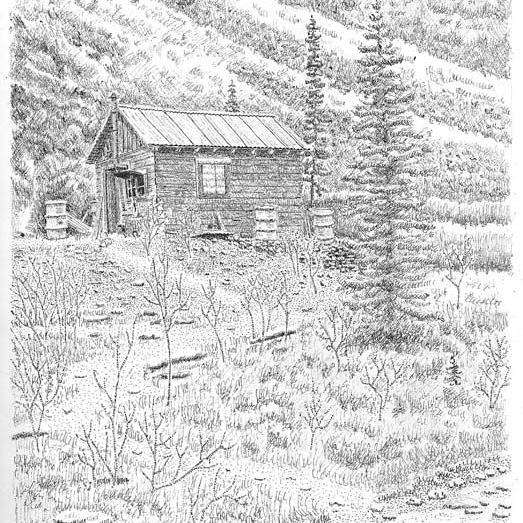
FAIRBANKS — Kantishna’s Eldorado Creek, as opposed to the 26 other Eldorado Creeks listed in the “Dictionary of Alaska Place Names,” is a 5.5-mile-long tributary of Moose Creek, located just downstream from the confluence of Moose and Eureka creeks. Mined since the short-lived 1905-06 Kantishna gold rush, Eldorado Creek’s mining history is a microcosm of the ebb and flow of mineral development in the Kantishna area.
During the brief six months the rush lasted, lode deposits of silver were discovered along Eldorado Creek, as well as a stibnite deposit (an ore of antimony) on Slate Creek, an Eldorado Creek tributary near its headwaters.
Mining picked up again during World War I. Slate Creek’s stibnite deposit was worked between 1915 and 1918, the Kantishna Hydraulic Mining Company mined along Moose Creek as far south as the mouth of Eldorado Creek until about 1922, and a silver deposit at the head of Eldorado Creek produced ore through 1923. Along with other Kantishna mines, those along Eldorado Creek were hampered by high transportation costs, as a road from the Alaska Railroad to Kantishna was not completed until 1939. Most mines, even those with rich deposits, were simply uneconomical to operate.
World War II brought gold and silver mining at Kantishna to a standstill, as it did elsewhere in Alaska, since the two metals were not vital for the war effort. However, stibnite was considered strategic (since antimony was used in munitions) and from 1942-44 it was mined at Slate Creek. During the war, a tractor road was pushed up Eldorado to Slate Creek.
Gold and silver mining resumed after World War II. Johnny Busia, who lived at Kantishna since 1918, opened the Comstock claims along the middle section of Eldorado Creek. At his claim he built the 12-foot by 16-foot wood-frame cabin shown in the drawing, now known as the Comstock cabin. Busia drove at least one adit (a horizontal entrance into a mine) into the hillside behind the cabin searching for silver. He later sold the claims to Frank Bonnell (relationship to me unknown) who excavated several more adits before abandoning the mine.
In 1959, Ed Ashbrook moved into the Kantishna area. He settled in to the Eldorado Creek area, acquiring 180 acres of patented claims. During a visit with him in 1994, he told me that he mined the lower portions of Eldorado Creek with a “dry-land dredge.’ Although I did not ask him specifics, dry-land dredges usually consist of a tracked excavator trailed by a mobile washing plant. Kantishna’s remoteness and shallow gravels played to these dredges’ strengths — small size, portability and economical operation without being hampered by their limited excavating depths.
Dan also related that when antimony was mined at Slate Creek in the early 1970s and again in the early 1980s (dependent on fluctuating metal prices) the road up Eldorado Creek was so smooth that he could drive his Cadillac all the way to the top. Mining at Slate Creek stopped in 1983, and in the following decade the mining road rapidly deteriorated. By the time I hiked it in 1994, much of it was just a rough trail along the creek bottom.
Recently, gold mining resumed along Eldorado Creek. After the 1980 expansion of Denali National Park to include the Kantishna Hills, and a subsequent 1985 lawsuit, mining ceased. Valid mining claims were not extinguished, though. The Park Service bought most of these claims, but in 2016, a plan of operation was approved for a suction-dredge operation on the last remaining unpatented mining claims within the park, along the middle section of Eldorado Creek near the Comstock cabin.
Ray Bonnell is a freelance artist, writer and longtime Fairbanks resident. See more of his artwork at www.pingostudio.us.
Sources:
• Conversations with Dan Ashbrook, Kantishna resident. 1994
• Conversation with Dave Shirokauer, Lead Science and Resource Team Leader, Denali National Park and Preserve. 2018
• “Crown Jewel of the North, an Administrative History of Denali National Park and Preserve, Volume 2, Chapter 14: Mining and Kantishna Area Management.” Frank Norris. National Park Service. 2006
• “Dictionary of Alaska Place Names.” Donald Orth. U.S.G.S. 1967
• “Eldorado Creek Mining Plan of Operations Environmental Assessment,” Steve Carwile,
• Britta Schroeder, & Linda Stromquist. National Park Service. May 2016
• Mindat.org mineralogical database — entries for Alpha and Comstock silver mines on Eldorado Creek, and Slate Creek stibnite mine
0 Response to "The ebb and flow of mining is reflected in Eldorado Creek's history - Fairbanks Daily News-Miner"
Post a Comment